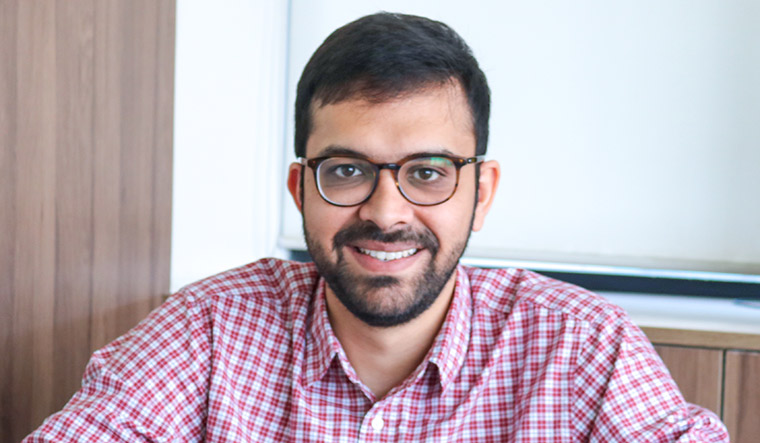VRUSABH SIDDHU was a fairly good student—he used to get by with self-study, guide books and some help from his mother. But troubles started after his father got transferred from his hometown Nagpur to Mumbai. He struggled to cope with the changed environs and the stress of the exams. The marks for mathematics, always an Achilles heel, spiralled dangerously downward.
Worried, Vrusabh joined a coaching centre, but found it was not of much help. “There were so many students in one class,” he says. “I was embarrassed to ask doubts in front of everyone.” It was then that he came across Toppr, a learning app. He tried the free sample lessons, and then persuaded his parents to shell out for the learning module he wanted for his board exams and the SAT (Scholastic Aptitude Test, used for admission to American colleges). “Textbooks are scary, but apps are simple, easy-to-use and effective,” says Vrusabh. He not only cleared the board exams, but also cracked the SAT, and is now off to the US to do an engineering course at the University of Pennsylvania.
In India, teaching is taking a tech-fuelled leap into a brave new future. Coaching centres, most of them with a focus on entrance tests, may have widespread reach, but the future seems to belong to app-based learning, with names like Byju’s, TopRankers, UnAcademy and Toppr becoming household names. Not to forget, they are equally popular among investors.
As per the national sample survey figures from 2016, more than seven crore Indian students took tuitions or attended coaching centres in addition to formal schooling. Of this, 20 to 30 lakh students currently subscribe to online educational apps or sites. With children’s education, along with health care and homes, being one of the three main categories where Indians do not hesitate to loosen their pursestrings, online education entrepreneurs expect a massive rise in the number and revenue. Indian parents, for instance, spent about Rs 1,800 crore on their children’s online supplementary education last year. According to a KPMG estimate, this will shoot up eight times, to almost Rs 14,000 crore, in two years. Around one crore students are expected to take to online apps by 2021.
That is good news for Byju Raveendran, virtually the poster boy of this sunrise industry. His Byju’s—The Learning App is the market leader, the brand name almost generic to the whole sector and plugged by Shah Rukh Khan on telly. “The real fun is not creating a billion-dollar company, but helping millions think and learn better,” he says.
Raveendran, who used to work in the shipping industry, started teaching to help friends clear competitive exams. He made it a full-time occupation in 2011, and established Think and Learn in Bengaluru. Though it was initially a coaching centre, he soon realised the potential of technology and started doing video teaching via satellite. He launched the app in 2015. “We realised that as the country gets more tech savvy, the smartphone as a learning device, and app as a medium, give us infinite reach for our learning programme,” says Raveendran.
It is exactly this immense potential that has enticed other startups and angel investors. “Investors have always been on the lookout for a disruptive B2C (business-to-consumer) opportunity in education, but the physical walls of classrooms as well as regulatory issues limited this, until now,” says Sandeep Aneja, managing partner of the Singapore-based investing firm Kaizen PE. “Technology has been the thoughtful answer.”
Toppr, UnAcademy and Gradeup are all scaling up their businesses thanks to soaring subscriptions and generous funding. Byju’s, the first firm in Asia to be funded by the Chan Zuckerberg Initiative of Facebook founder Mark Zuckerberg and wife, Priscilla, is now valued around $5.4 billion. It is now the fourth most valued Indian startup, after Flipkart, Paytm and Ola.
One of the biggest reasons for these platforms’ popularity is that the tool adapts to a student’s pace, helping him virtually have his “own individual classrooms,” as Zishaan Hayath, CEO and cofounder of Toppr, puts it. “In traditional teaching, you cannot possibly have different classrooms. For example, among two class 12 students preparing for engineering entrance, one may be preparing for SAT while the other may be trying for BITS and IIT. With technology, we can create different courses tailored for each,” he says.
These entrepreneurs have been rapidly scaling up their businesses. While Byju’s roped in Shah Rukh for their big-budget advertising onslaught, the smaller players have tried other innovative methods. Toppr, for instance, uses a posse of on-ground salesmen to visit homes and convince parents how the app can be beneficial for their children. Byju’s Parent Connect app gives real-time updates on a student’s progress to the parents. Gradeup has been focusing on smaller cities using targeted Google and Facebook ads.
The naysayers’ main grouse was that the tech interface leaves no space for human interaction. This has been addressed by chat windows and options to connect to tutors. “We go deeper, giving personalised guidance to our students from some of the top teachers in the country,” says Shobhit Bhatnagar, cofounder of Gradeup. “Students use the chat option to share information and help others, leading to that sense of community.”
It is a community which is expanding fast, and the industry is gung-ho on big growth. Byju’s is planning a new app this year for lower grades even as it plans its international launch in collaboration with popular YouTube teachers. Many of the other players plan to tap the Indian hinterland for further growth. “This segment is underpenetrated,” says Bhatnagar. “Established brick-and-mortar coaching centres are ten times more expensive than online courses, and their quality goes down once you move out of big cities.”
Vipul Jain, serial entrepreneur and investor, agrees. “More and more four and five-tier towns are now getting online, and this population is getting access to world-class learning infrastructure that formal education is not able to provide. In such a scenario, there is a huge market,” he says. But the biggest approval to the prospects of this sector comes from the ‘classroom’ coaching giants like Rau’s, Aakash and Vision IAS—most of them now have an online presence, either on digital learning sites or as an educational app.





